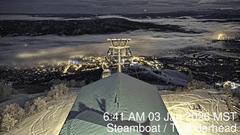Fall storm wallops Steamboat
Monday, October 2, 2017
The strong winter-like storm that is still gripping the Steamboat Springs area has left 19” of snow containing about 2.4” of liquid water at the top of Sunshine Peak near Patrol Headquarters, as shown by the current Steamboat Powdercam, and about 6” on my deck near the base of Mt. Werner. In the Yampa Valley, the rain that started around 2:30 Saturday afternoon left about an inch of water by Sunday morning. By mid-morning Sunday, the rain had changed to snow, certainly much earlier than my Thursday forecast, and continued through Monday morning, leaving about another inch of liquid water in the valley.
The cold air associated with this storm, sourced from the North Pole, was not to be slowed by the southwest flow aloft, and snow levels dropped faster and further than originally forecast. Snow showers will taper off through the afternoon today, with another weak round of showers possible around midnight.
Some drier air should move over our area after midnight, and if skies clear, temperatures will fall to the lowest levels of the season so far. Below normal temperatures will persist into Wednesday as the sun’s energy goes into melting the snow rather than warming the atmosphere.
As this storm lifts to our northeast by midweek, another storm moving southward from British Columbia briefly stalls in Nevada through midweek. This will keep southwest flow over our area until the end of the work week and we will see warming temperatures under continued mostly sunny skies.
As energy traveling across the Pacific crosses the British Columbia coast around Friday and energizes the jet stream, the Nevada storm is ejected to the east and northeast, moving over or near our area sometime on Friday. This storm will be quite dry, likely with no precipitation, but it should knock temperatures back a bit for Friday.
Uncertainty emerges for the weekend as it is not clear how strong and how far south the Pacific jet stream will travel as it sags southward across the Intermountain West after crossing the West Coast. Earlier forecasts had significant warming and drying over Colorado for the weekend, but current numerical model forecasts now have the jet stream pushing further south, and this will likely limit the previously advertised warming and drying as cooler air and clouds lurk to our north.








